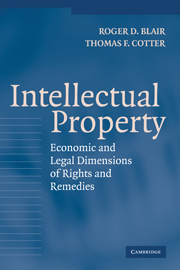Book contents
- Frontmatter
- Contents
- Acknowledgments
- 1 Introduction
- 2 The Law and Economics of IPRs
- 3 A General Theory of Damages Rules
- 4 Departures from the General Theory
- 5 Liability Standards for IPRs
- 6 Who Is an Infringer?
- 7 Who Should Be Entitled to Sue for Infringement?
- 8 Calculating Monetary Damages
- 9 Concluding Remarks
- Bibliography
- Index
9 - Concluding Remarks
Published online by Cambridge University Press: 08 January 2010
- Frontmatter
- Contents
- Acknowledgments
- 1 Introduction
- 2 The Law and Economics of IPRs
- 3 A General Theory of Damages Rules
- 4 Departures from the General Theory
- 5 Liability Standards for IPRs
- 6 Who Is an Infringer?
- 7 Who Should Be Entitled to Sue for Infringement?
- 8 Calculating Monetary Damages
- 9 Concluding Remarks
- Bibliography
- Index
Summary
Intellectual property law, which covers patents, trade secrets, copyrights, and trademarks, confers a set of exclusive rights in a variety of subject matter, including inventions, useful information, creative expression, and commercial symbols. This subject matter is often the product or embodiment of investments of scarce resources such as human capital, time, energy, money, and a vast array of other resources. These investments must be made before any return can be realized. In some cases, the investment may be nominal – some songs may be written in an afternoon. In other cases, the investments may be quite substantial. For example, a pharmaceutical manufacturer may have to invest hundreds of millions of dollars over many years before it receives the first dime of sales revenue. The fundamental assumption of our system of IPRs is that social welfare is enhanced by conferring exclusive rights on those who produce or disseminate these forms of information. Because exclusive rights may enable the owner to control quantity and price, however, access to the resulting creation may be restricted. Thus, a socially optimal system of IPRs will strike a delicate balance between encouraging investment, on the one hand, and insuring access, on the other. With the exception of a few caveats sprinkled here and there, we have proceeded on the (perhaps heroic) assumption that our current system of IPRs is, in fact, socially optimal. Although we recognize that this assumption may be incorrect, that issue is the subject of a very different book.
- Type
- Chapter
- Information
- Intellectual PropertyEconomic and Legal Dimensions of Rights and Remedies, pp. 263 - 266Publisher: Cambridge University PressPrint publication year: 2005



